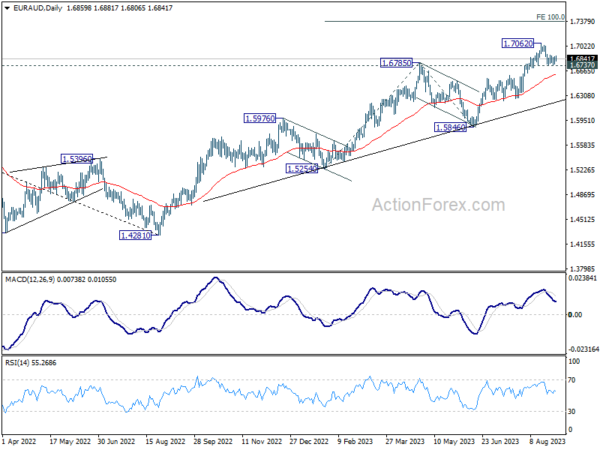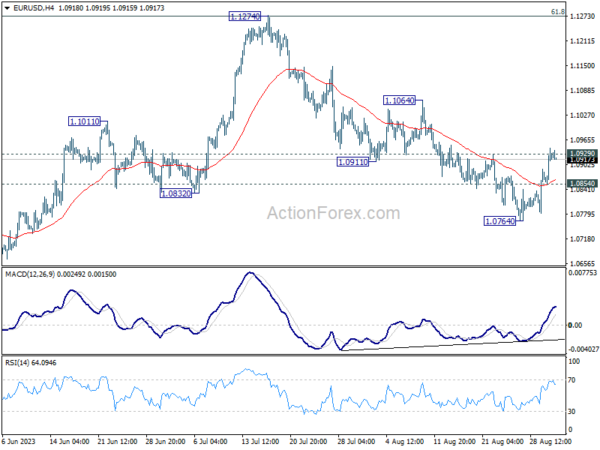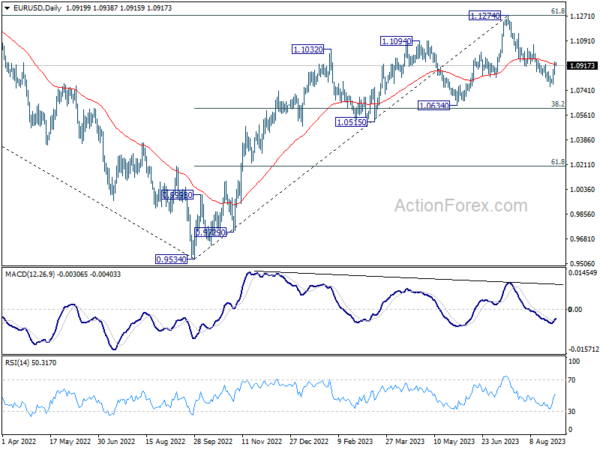Markets took a breather in today’s Asian trading session after Dollar experienced a significant selloff overnight. For now, the greenback seems to have found some footing, as market participants shift their focus to the release of high-impact data—Eurozone’s CPI flash and US PCE inflation—slated for later today. Eurozone inflation report is particularly critical as it could have a direct influence on ECB decision to either hike interest rates again or hit pause during its September meeting. Traders should also brace for a potential market jolt with US non-farm payroll data due out tomorrow. A roller coaster of market movements can be expected for the rest of the week.
As it stands, Dollar has been the week’s worst performer, trailed by Yen and Canadian Dollar. On the other side of the currency spectrum, Australian Dollar is leading the pack, followed by Euro, Sterling, and then Kiwi. The ongoing interplay between these European major and commodity currencies remains an interesting subplot; it’s still unclear which currency will emerge as the week’s winner, especially if Dollar’s selloff gains more momentum.
Technically, EUR/AUD is holding firm above 1.6737 support for now, keeping near term outlook bullish. That is, another rise is in favor through 1.7062 to resume larger up trend. In that case, next target is 100% projection of 1.5254 to 1.6785 from 1.5846 at 1.7377. However, firm break of 1.6737 will at least bring deeper correction to 55 D EMA (now at 1.6613), and possibly below. We’ll know the answer soon as pivotal data releases loom on the horizon.

In Asia, at the time of writing, Nikkei is up 1.03%. Hong Kong HSI is down -0.50%. China Shanghai SSE is down -0.68%. Singapore Strait Times is up 0.49%. Japan 10-year JGB yield is down -0.002 at 0.653. Overnight, DOW rose 0.11%. S&P 500 rose 0.38%. NASDAQ rose 0.54%. 10-year yield dropped -0.004 to 4.118.
Japan’s industrial production slips -2% in Jul, but retail sales resilient
Japan’s industrial production took a hit in July, falling by a worse-than-expected -2.0% mom, versus consensus forecast of -1.4% mom. The seasonally adjusted production index stumbled to 103.6, based on 2020 base of 100.
Production was primarily pulled down by substantial drops in electronic parts and devices, which declined -by 5.1% mom. Also, production machinery output shrank by -4.8% mom, with semiconductor manufacturing equipment segment plunging a stark 16.4% mom. However, not all was grim. Production of automobiles showed a modest uptick of 0.6% mom, attributed to the easing of supply chain bottlenecks.
A Ministry of Economy, Trade, and Industry official remarked that the slump in output across various sectors was largely due to diminishing domestic and overseas orders. Consequently, METI has revised its assessment of industrial output from “showing signs of moderately picking up” to “fluctuated indecisively.”
Despite the grim industrial landscape, manufacturers surveyed by METI are optimistic, projecting a 2.6% rise in output for August and a 2.4% increase in September.
In contrast to the industrial sector’s lackluster performance, retail sales exhibited considerable strength. Sales surged 6.8% yoy in July, beating expectations of a 5.4% yoy increase. This marks the 17th consecutive month of expansion since March 2022. Additionally, retail sales increased 2.1% mom in July, recovering from a -0.6% mom decline in the previous month.
BoJ Nakamura: Achievement of 2% inflation isn’t in sight yet
In a marked contrast to fellow BoJ board member Naoki Tamura’s recent remarks, Toyoaki Nakamura, known for his dovish stance, stressed the need for a more cautious approach towards tightening Japan’s monetary policy. Speaking at an event, Nakamura noted, “Sustainable and stable achievement of our 2% inflation isn’t in sight yet. We therefore need more time before shifting to monetary tightening.”
Nakamura emphasized the necessity for “close scrutiny of conditions and cautious decision-making” when it comes to modifications in Japan’s ultra-loose monetary policy. He further cited weakening economic signs in China and potential ripple effects of aggressive US interest rate hikes as risks clouding Japan’s economic outlook.
Interestingly, Nakamura was the sole dissenting voice last month against the BoJ’s decision to loosen its grip on yield curve control, underscoring his position as the board’s most dovish member. His comments are in stark contrast to those of board member Naoki Tamura, who expressed optimism yesterday that BoJ could have sufficient data by the first quarter of 2024 to assess whether the 2% inflation target could be met sustainably.
NZ ANZ business confidence rose to -3.7, the worst could be over
New Zealand’s ANZ Business Confidence index showed a marked improvement in August, rising from -13.1 to -3.7. The data suggests a positive shift in the economic outlook among New Zealand businesses. Own Activity Outlook also jumped from a tepid 0.8 to a robust 11.2.
Several other sub-indicators within the report signaled optimism. Export intentions rose from 1.5 to 7.5, indicating that businesses are more confident about overseas demand. Investment intentions climbed from -3.3 to -1.3, suggesting that companies are less hesitant about capital expenditures. Employment intentions also saw a notable uptick, moving from -1.6 to 4.6, pointing to potential job market expansion.
On the inflationary front, businesses appear to be less worried. Cost expectations decreased from 80.6 to 75.3, pricing intentions fell from 48.1 to 44.0, and inflation expectations eased marginally from 5.14 to 5.06. This cooling in inflationary pressure might be a welcome sign for both the market and RBNZ.
In their commentary, ANZ stated: “Many firms appear to have been pleasantly surprised at how well demand has held up, considering; and the Reserve Bank has stopped raising the OCR (Official Cash Rate), (while reserving the right to change their minds), which may be creating a sense that the worst is over.”
China’s PMI manufacturing edges up to 49.7, fifth month in contraction
China’s official PMI Manufacturing for August rose slightly to 49.7, surpassing market expectations of 49.5. Despite the increment, this marks the fifth consecutive month that the metric is below the 50-threshold, signaling a contraction in the manufacturing sector.
Key sub-indexes within the PMI data painted a mixed picture. Production sub-index saw improvement, rising from 50.2 in July to 51.9 . Similarly, the gauge for new orders nudged up to 50.2 from 49.5. On the downside, new export orders sub-index stayed low at 46.7, though it was slightly up from 46.3 , marking its fifth consecutive month in contraction territory.
Manufacturers’ business expectations did see some improvement, rising from 55.1 to 55.6, indicating a slight uptick in future outlook despite current headwinds.
Zhao Qinghe, a senior official from China’s National Bureau of Statistics, commented on the situation. “The survey results show that insufficient market demand is still the main problem that enterprises are facing, and the foundation for the recovery and development of the manufacturing industry needs to be further consolidated,” he said.
Meanwhile, PMI Non-Manufacturing fell from 51.5 to 51.0, missing market expectations of 51.1, although it still remains in the expansionary territory above 50.
Looking ahead
Eurozone CPI flash is the highlight in European session, while unemployment rate will be featured. . ECB will also release meetings accounts but they’re unlikely to reveal anything new. Germany retail sales and unemployment. France will release consumer spending.
Later in the day, main focuses will be on US PCE inflation, while personal income and spending will be published together. Jobless claims and Chicago PMI will also be featured.
EUR/USD Daily Outlook
Daily Pivots: (S1) 1.0870; (P) 1.0908; (R1) 1.0960; More…
Focus stays on 1.0929 in EUR/USD as the pair is still struggling around this resistance. Sustained break of 1.0929 argue that the corrective fall from 1.1274 has completed with three waves down to 1.0764. Further rally would then be seen to 1.1064 resistance for confirmation. Meanwhile, rejection by 1.0929 will retain near term bearishness. Break of 1.0854 minor support will resume the decline through 1.0764, to 1.0609/34 cluster support next.

In the bigger picture, fall from 1.1274 medium term top is seen as a correction to up trend from 0.9534 (2022 low). Deeper decline would be seen to 1.0634 cluster support (38.2% retracement of 0.9534 to 1.1274 at 1.0609). Strong support could be seen there, at least on first attempt, to bring rebound. Yet, medium term outlook will be neutral for now, as long as 1.1274 resistance holds.

Economic Indicators Update
| GMT | Ccy | Events | Actual | Forecast | Previous | Revised |
|---|---|---|---|---|---|---|
| 23:50 | JPY | Industrial Production M/M Jul P | -2.00% | -1.40% | 2.40% | |
| 23:50 | JPY | Retail Trade Y/Y Jul | 6.80% | 5.40% | 5.90% | |
| 01:00 | NZD | ANZ Business Confidence Aug | -3.7 | -13.1 | ||
| 01:00 | CNY | NBS Manufacturing PMI Aug | 49.7 | 49.5 | 49.3 | |
| 01:00 | CNY | Non-Manufacturing PMI Aug | 51 | 51.1 | 51.5 | |
| 01:30 | AUD | Private Capital Expenditure Q2 | 2.80% | 1.10% | 2.40% | 3.70% |
| 05:00 | JPY | Housing Starts Y/Y Jul | -6.70% | -0.80% | -4.80% | |
| 06:00 | EUR | Germany Retail Sales M/M Jul | 0.30% | -0.80% | ||
| 06:45 | EUR | France Consumer Spending M/M Jul | 0.30% | 0.90% | ||
| 06:45 | EUR | France GDP Q/Q Q2 | 0.50% | 0.50% | ||
| 07:55 | EUR | Germany Unemployment Change Jul | 10K | -4K | ||
| 07:55 | EUR | Germany Unemployment Rate Jul | 5.60% | 5.60% | ||
| 08:00 | EUR | Italy Unemployment Jul | 7.40% | 7.40% | ||
| 09:00 | EUR | Eurozone Unemployment Rate Jul | 6.40% | 6.40% | ||
| 09:00 | EUR | Eurozone CPI Y/Y Aug P | 5.10% | 5.30% | ||
| 09:00 | EUR | Eurozone CPI Core Y/Y Aug P | 5.30% | 5.50% | ||
| 11:30 | EUR | ECB Monetary Policy Meeting Accounts | ||||
| 12:30 | CAD | Current Account (CAD) Q2 | -11.1B | -6.2B | ||
| 12:30 | USD | Initial Jobless Claims (Aug 25) | 227K | 230K | ||
| 12:30 | USD | Personal Income M/M Jul | 0.30% | 0.30% | ||
| 12:30 | USD | Personal Spending Jul | 0.70% | 0.50% | ||
| 12:30 | USD | PCE Price Index M/M Jul | 0.20% | 0.20% | ||
| 12:30 | USD | PCE Price Index Y/Y Jul | 3.30% | 3.00% | ||
| 12:30 | USD | Core PCE Price Index M/M Jul | 0.20% | 0.20% | ||
| 12:30 | USD | Core PCE Price Index Y/Y Jul | 4.20% | 4.10% | ||
| 13:45 | USD | Chicago PMI Aug | 44.1 | 42.8 | ||
| 14:30 | USD | Natural Gas Storage | 20B | 18B |









